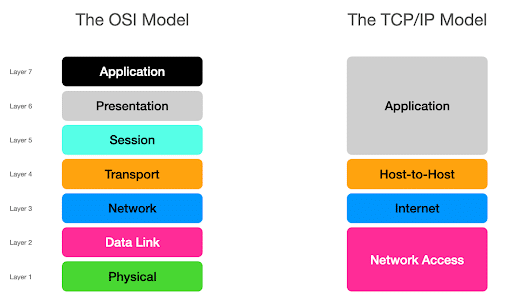TCP(Transmission Control Protocol) Model

Transmission Control Protocol/ Internet Protocol is a network model which is based on some standard protocols, developed by the Department of Defense(DoD) in the 1960s to support communication between different network devices on the internet.
The TCP/IP is divided into 5 layers, each containing it specific protocols. The layers are:
Application Layer
Transport Layer
Network Layer
Data Link Layer
Physical Layer
Physical Layer
This layer converts the message bits into signals for transmission on a medium i.e, physical layer is the place where real communications takes place.
Signals are generated depending on the type of media used to connect two devices. For example, light signals are generated for optical fibers, electrical signals are generated for copper cables etc.
Physical layer also specifies characteristics like topology(bus, star, mesh, hybrid, ring) line configuration (point-to-point, multi-point) and transmission mode(simplex, half-duplex or full-duplex).
Data Link Layer
It is sub-divided into two parts: MAC(Media Access Control) and LLC(Logical Link Control).
MAC - The MAC layer is responsible for data encapsulation of IP packets from the network layer into frames. Means DLL will add a header (MAC address of source and destination) and a trailor (which contains error checking data) at the start and end of IP packets.
LLC - the LLC deals with the flow control of the data packets and also the error control.
Flow control limits how much data a sender can transfer without overwhelming the receiver.
Error control is done by checking the bits in the trailor of the frame.
Network Layer
The network layer adds IP address/ logical address to the data segments to form IP packets and finds the best possible for data delivery. IP addresses are addresses assigned to devices to uniquely identify it on a global scale.
Transport Layer
It is in charge of flow control, end-to-end connectivity and error-free data transmission. Protocols used in transport layer are:
TCP: it is a connection oriented protocol, which means it requires the formation and termination of connections between devices in order to transmit data. TCP segmentation means that at the sending node, TCP breaks the entire message into segments, assign a sequence number to each segment, then reassembles the segments into original message in the receiver end based on sequence number. It is reliable protocol because it identifies errors and retransmits the damaged data.
UDP: User Datagram Protocol. It is a connectionless protocol, which means it does not require the establishment of connections and termination of connections between the devices. Serves live videos or online games.
Application Layer
This is the uppermost layer which combines the application, session and presentation layer in the OSI. Users can access network resources and interact with the application through this layer.
Protocols used are: HTTP DNS TELNET SMPT FTP.